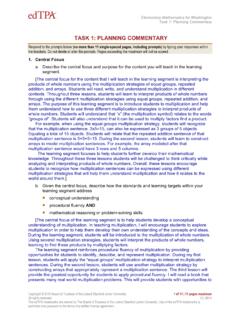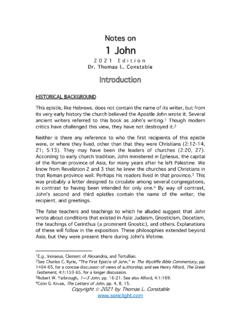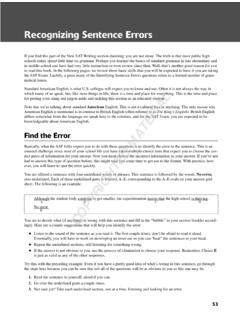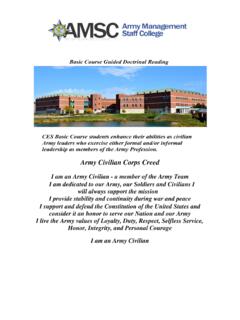Transcription of TASK 3: ASSESSMENT COMMENTARY - Miss Jesse Jewett
1 Elementary Mathematics for Washington task 3 : ASSESSMENT COMMENTARY Copyright 2014 Board of Trustees of the Leland Stanford Junior University. 1 of 12 | 12 pages maximum All rights reserved. V3_0914 The edTPA trademarks are owned by The Board of Trustees of the Leland Stanford Junior University. Use of the edTPA trademarks is permitted only pursuant to the terms of a written license agreement. task 3 : ASSESSMENT COMMENTARY Respond to the prompts below (no more than 12 single-spaced pages, including prompts) by typing your responses within the brackets following each prompt. Do not delete or alter the prompts. COMMENTARY pages exceeding the maximum will not be scored. Attach the ASSESSMENT you used to evaluate student performance (no more than 5 additional pages) to the end of this file. If you submit a video or audio clip of feedback or a work sample and you or the focus students are occasionally inaudible, attach a transcription (no more than 2 additional pages) to the end of this file.
2 These pages do not count toward your page total. 1. Analyzing Student Learning a. Identify the specific learning targets and standards measured by the ASSESSMENT you chose for analysis. [The ASSESSMENT that I have chosen for analysis measures the learning targets from each of the three learning segments. The learning targets that are measured by the ASSESSMENT are as listed: -Interpreting products of whole numbers using repeated addition and groups. -Interpreting products of whole numbers through arrays. -Using multiplication within 100 to understand word problems in situations involving equal groups and arrays. The standard that my chosen ASSESSMENT measures is from Lesson 3, Use multiplication within 100 to solve word problems in situations using equal groups and arrays.] b. Provide a graphic (table or chart) or narrative that summarizes student learning for your whole class.
3 Be sure to summarize student learning for all evaluation criteria submitted in task 3 , Part D. [The following table summarizes student learning for the whole class: Student Mathematical Conceptual Understanding (3 points) Representation (3 points) Neatness (3 points) Total (9 points) Advanced Student 1 (Focus Student 1) 3 3 3 9 Advanced Student 2 3 3 3 9 Advanced Student 3 3 3 3 9 Advanced Student 4 3 3 3 9 Advanced Student 5 3 3 3 9 Advanced Student 6 3 3 3 9 IEP Student 1 3 3 3 9 IEP Student 2 1 (no attempt) 1 2 Math Struggler 1 1 3 2 6 Math Struggler 2 3 3 3 9 Elementary Mathematics for Washington task 3 : ASSESSMENT COMMENTARY Copyright 2014 Board of Trustees of the Leland Stanford Junior University. 2 of 12 | 12 pages maximum All rights reserved. V3_0914 The edTPA trademarks are owned by The Board of Trustees of the Leland Stanford Junior University.]
4 Use of the edTPA trademarks is permitted only pursuant to the terms of a written license agreement. Math Struggler 3 (Focus Student 3) 1 3 2 6 504 Student 1 1 3 3 7 Average Student 1 (Focus Student 2) 2 3 2 7 Average Student 2 3 3 2 8 Average Student 3 3 3 3 9 Average Student 4 0 0 3 3 Average Student 5 3 3 3 9 Average Student 6 3 3 3 9 Average Student 7 3 3 3 9 Average Student 8 3 3 3 9 Average Student 9 3 3 3 9 Average Student 10 3 3 3 9 Average Student 11 3 3 2 8 Average Student 12 3 3 3 9 Average Student 13 3 3 3 9 Total for each Criteria: 63/75 69/75 67/75 Class Average Points Earned: 8 The student work was evaluated and based on their mathematical conceptual understanding, representation, and neatness, as identified on the evaluation criteria. Of the class, 84% of students scored well on mathematical conceptual understanding, 92% of students scored well on representation, and 89% of students scored well on neatness.
5 ] c. Provide a graphic (table or chart) or narrative that summarizes student understanding of their own learning progress (student voice). [During the first lesson, students had little understanding of the concepts of multiplication and how equal groups and arrays could be used to represent multiplication sentences , as this was their first formal introduction to multiplication. I was able to recognize their understanding by eliciting student voice. For example, I asked students to tell me what they knew about multiplication during an activity called Think, Pair, and Share . During this exercise, they were able to tell me that multiplication had to do with addition, but were unable to provide me with an example or reasoning for their definition. One student even pointed out that by using Elementary Mathematics for Washington task 3 : ASSESSMENT COMMENTARY Copyright 2014 Board of Trustees of the Leland Stanford Junior University.
6 3 of 12 | 12 pages maximum All rights reserved. V3_0914 The edTPA trademarks are owned by The Board of Trustees of the Leland Stanford Junior University. Use of the edTPA trademarks is permitted only pursuant to the terms of a written license agreement. multiplication, you no longer would need to add, 9 + 9 + 9, for example, but rather, you could multiply 9 x 3. After introducing students to equal groups during the first lesson, they practiced rolling dice to express multiplication sentences using equal groups. Most students understood that the first number they rolled represented the number of groups. However, many students were having trouble recognizing the role of the second roll. What students should have been doing was putting that number of dots in each of the previously drawn groups. Unfortunately, some students were trying to spread the number of the second roll through out the groups, not necessarily providing an equal number in each group.
7 For example, one student rolled a 3 first. After drawing 3 circles to represent the 3 groups, the same student rolled a 6. Rather than placing 6 dots in each of their 3 circles, as they should have, the student put 2 dots in each group. After observing this, I got the attention of the class and did an example with them. I rolled a 4 the first time, drawing 4 circles on a page to show them. Next, I rolled a 3. I then went on to put three dots in each circle, explaining again to the class that the second roll is the amount of dots that go in each group. Later, I double-checked with the student mentioned earlier, to double check that she understood the second roll, which she did. During the second lesson, students were using arrays to represent multiplication sentences . Overall, students seemed to demonstrate a deeper understanding of arrays than equal groups.
8 An array was described to them as a picture of a multiplication sentence. The vocabulary words row and column were difficult for students to differentiate between. After realizing that they were struggling to remember which direction each word went, I tried to connect the words to experiences related to my students. I described a column by reminding students of the vertical list their spelling words are arranged in each week. This example resonated with a number of students. The horizontal direction of a row was described to the students in the way that movie theatre seats are arranged. These visual reminders helped students differentiate between rows and columns when creating an array. As we progressed through the third lesson, students struggled to understand how multiplication related to story problems and real life scenarios.
9 As a class, using personal whiteboards at their tables, students worked through multiple real life scenarios with me. I wrote a problem relating to the learning target on the board. After allowing students adequate time to solve it on their own, I worked through it on the large, classroom whiteboard. In an effort to keep the students engaged, I worked through it based on their responses. For example, I began by asking students, What is the first thing I should do? This kept students engaged, as well as gave them the opportunity to verbally explain their understanding of the mathematical concepts. The problems encouraged students to use arrays and equal groups to interpret multiplication sentences . At the end of the lesson, after looking at student scores, I realized that there are still students who will need additional guidance and practice understanding the concepts.
10 ] d. Use evidence found in the 3 student work samples, student self-reflections, and the whole class summary to analyze the patterns of learning for the whole class and differences for groups or individual learners relative to ! conceptual understanding ! procedural fluency AND ! mathematical reasoning or problem-solving skills Consider what students understand and do well, and where they continue to struggle ( , common errors , confusions, need for greater challenge). [Evidence of feedback is written on the student work samples, submitted in Task 3A. In analyzing the three student work samples, student self-reflections, and the whole class Elementary Mathematics for Washington task 3 : ASSESSMENT COMMENTARY Copyright 2014 Board of Trustees of the Leland Stanford Junior University. 4 of 12 | 12 pages maximum All rights reserved.




